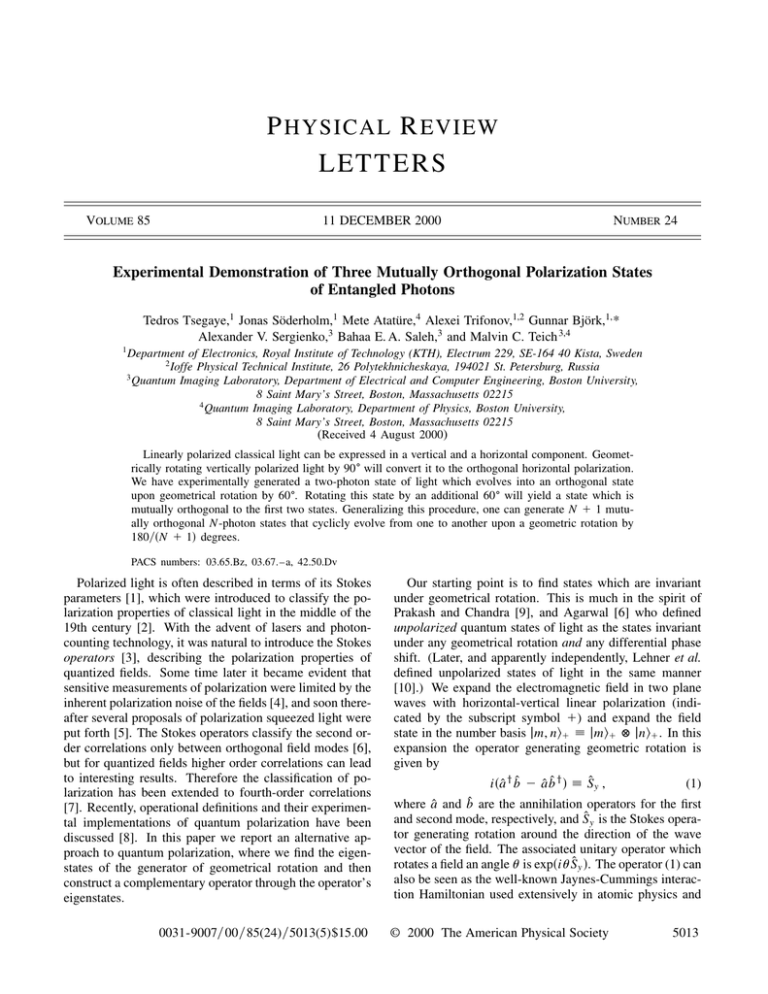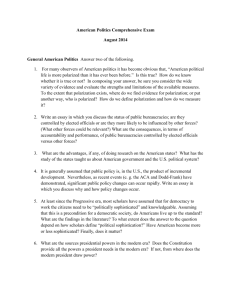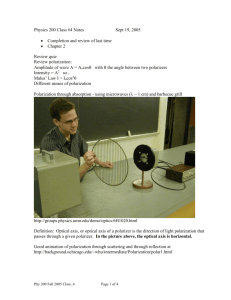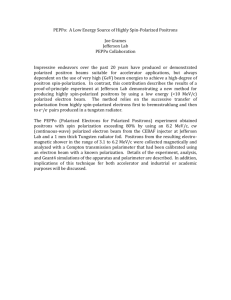P R L E T T E R S HYSICAL
advertisement

P HYSICAL R EVIEW LETTERS VOLUME 85 11 DECEMBER 2000 NUMBER 24 Experimental Demonstration of Three Mutually Orthogonal Polarization States of Entangled Photons Tedros Tsegaye,1 Jonas Söderholm,1 Mete Atatüre,4 Alexei Trifonov,1,2 Gunnar Björk,1, * Alexander V. Sergienko,3 Bahaa E. A. Saleh,3 and Malvin C. Teich 3,4 1 Department of Electronics, Royal Institute of Technology (KTH), Electrum 229, SE-164 40 Kista, Sweden 2 Ioffe Physical Technical Institute, 26 Polytekhnicheskaya, 194021 St. Petersburg, Russia 3 Quantum Imaging Laboratory, Department of Electrical and Computer Engineering, Boston University, 8 Saint Mary’s Street, Boston, Massachusetts 02215 4 Quantum Imaging Laboratory, Department of Physics, Boston University, 8 Saint Mary’s Street, Boston, Massachusetts 02215 (Received 4 August 2000) Linearly polarized classical light can be expressed in a vertical and a horizontal component. Geometrically rotating vertically polarized light by 90± will convert it to the orthogonal horizontal polarization. We have experimentally generated a two-photon state of light which evolves into an orthogonal state upon geometrical rotation by 60±. Rotating this state by an additional 60± will yield a state which is mutually orthogonal to the first two states. Generalizing this procedure, one can generate N 1 1 mutually orthogonal N-photon states that cyclicly evolve from one to another upon a geometric rotation by 180兾共N 1 1兲 degrees. PACS numbers: 03.65.Bz, 03.67.– a, 42.50.Dv Polarized light is often described in terms of its Stokes parameters [1], which were introduced to classify the polarization properties of classical light in the middle of the 19th century [2]. With the advent of lasers and photoncounting technology, it was natural to introduce the Stokes operators [3], describing the polarization properties of quantized fields. Some time later it became evident that sensitive measurements of polarization were limited by the inherent polarization noise of the fields [4], and soon thereafter several proposals of polarization squeezed light were put forth [5]. The Stokes operators classify the second order correlations only between orthogonal field modes [6], but for quantized fields higher order correlations can lead to interesting results. Therefore the classification of polarization has been extended to fourth-order correlations [7]. Recently, operational definitions and their experimental implementations of quantum polarization have been discussed [8]. In this paper we report an alternative approach to quantum polarization, where we find the eigenstates of the generator of geometrical rotation and then construct a complementary operator through the operator’s eigenstates. 0031-9007兾00兾85(24)兾5013(5)$15.00 Our starting point is to find states which are invariant under geometrical rotation. This is much in the spirit of Prakash and Chandra [9], and Agarwal [6] who defined unpolarized quantum states of light as the states invariant under any geometrical rotation and any differential phase shift. (Later, and apparently independently, Lehner et al. defined unpolarized states of light in the same manner [10].) We expand the electromagnetic field in two plane waves with horizontal-vertical linear polarization (indicated by the subscript symbol 1) and expand the field state in the number basis jm, n典1 ⬅ jm典1 ≠ jn典1 . In this expansion the operator generating geometric rotation is given by i共ây b̂ 2 âb̂ y 兲 ⬅ Ŝy , (1) where â and b̂ are the annihilation operators for the first and second mode, respectively, and Ŝy is the Stokes operator generating rotation around the direction of the wave vector of the field. The associated unitary operator which rotates a field an angle u is exp共iu Ŝy 兲. The operator (1) can also be seen as the well-known Jaynes-Cummings interaction Hamiltonian used extensively in atomic physics and © 2000 The American Physical Society 5013 VOLUME 85, NUMBER 24 PHYSICAL REVIEW LETTERS in cavity quantum electrodynamics. It describes a linear coupling between two oscillators, in this case, e.g., a vertically and a horizontally polarized electromagnetic field of the same frequency. We note that Ŝy commutes with the total excitation operator ây â 1 b̂ y b̂ (which is the Stokes operator Ŝ0 ) so the total excitation number is an invariant under geometrical rotation. It therefore makes sense to look at the field in each excitation manifold separately. Let us look at a state in excitation manifold N spanned by N 1 1 basis states j0, N典1 , j1, N 2 1典1 , . . . , jN, 0典1 . It is well known from the theory of linear coupling of bosonic oscillators with total excitation N that the eigenstates to the Jaynes-Cummings Hamiltonian (1) are dressed states j±共N兲 n 典 differing in eigenvalue by DE 苷 2. The states are nondegenerate and orthogonal, and therefore provide an alternative basis for expanding any state in excitation manifold N. To exemplify, we explicitly express these states in the N 苷 2 excitation manifold: p 共2兲 j±1 典 苷 共j0, 2典1 2 i 2 j1, 1典1 2 j2, 0典1 兲兾2 , (2) p 共2兲 j±2 典 苷 共j0, 2典1 1 j2, 0典1 兲兾 2 , (3) p 共2兲 j±3 典 苷 共j0, 2典1 1 i 2 j1, 1典1 2 j2, 0典1 兲兾2 . (4) These states are eigenstates of Ŝy with eigenvalues 2共n 2 1兲 2 N and are circularly polarized since they are invariant under any geometrical rotation around the wave vector. If the field represented by the left (right) index in the kets in Eqs. (2)–(4) stands for the oscillation in the hori共2兲 zontal (vertical) direction, then we can identify j±1 典 and 共2兲 j±3 典 as left- and right-hand polarized states (assuming a harmonic time dependence e2i共vt2kr兲 ). Expanded in a circularly polarized mode basis (left, right), indicated by the 共2兲 共2兲 subscript ±, the states are j±1 典 苷 j2, 0典±, j±2 典 苷 j1, 1典±, 共2兲 共2兲 and j±3 典 苷 j0, 2典±. The state j±2 典 is symmetric with respect to the two oscillation modes. This was already noted in [10,11]. We suggest the state be called a neutrally polarized state (which should be distinguished from unpolarized light [6,9,10]). We see that just like classically polarized light, the left-hand polarized state will be transformed into the right-hand polarized state under a relative phase shift of p between the two modes, and vice versa. This can be accomplished with a l兾2 plate inserted at any angle. The neutrally polarized state is invariant under this transformation. (Similar rotational invariance, but in the context of two polarization-entangled states, has already been demonstrated [12].) In classical optics the “complementary” polarization to circular is linear. A linearly polarized field has the property that vertical (horizontal) polarization evolves to horizontal (vertical) polarization upon a geometrical rotation of 90±. A set of states with similar properties can be constructed in manifold N as N11 X 1 共N兲 jzk 典 苷 p eip共k21兲n兾共N11兲 j±共N兲 (5) n 典, N 1 1 n苷1 5014 11 DECEMBER 2000 where k 苷 0, 1, . . . , N. The principle of construction is identical to the construction of Pegg-Barnett phase states and relative phase states [13]. (A somewhat similar construction for excitation manifold 2 is proposed in [14] to achieve a ternary logic based on two-photon states.) All the N 1 1 states in the set are mutually orthonormal. Further共N兲 共N兲 more, state jzk 典 evolves into state jzk1l 典, where k 1 l should be taken modulus N 1 1, upon geometrical rotation by an angle pl兾共N 1 1兲 around the wave vector. In this sense the states are similar to classical linearly polarized fields. However, in contrast to their classical counterparts, the states do not have their electric-field oscillation confined to one spatial direction. We note that any unitary rotation that leaves the circularly polarized states (2)–(4) invariant will transform the states defined by (5) to states with identical properties with the respect of rotation. Such a unitary transfor共2兲 共2兲 mation must have the form Û 苷 exp共im兲 j±1 典 具±1 j 1 共2兲 共2兲 共2兲 共2兲 The choice exp共in兲 j±2 典 具±2 j 1 exp共ix兲 j±3 典 具±3 j. m 苷 0, n 苷 p兾2, x 苷 0 (this particular choice will be motivated below) will generate the set of states p 12i 2 1 共2兲 jz1 典 苷 p j0, 2典1 2 p j1, 1典1 12 2 p 11i 2 2 p (6) j2, 0典1 , 12 p p 21i 22i 共2兲 jz2 典 苷 p (7) j0, 2典1 2 p j2, 0典1 , 6 6 p 12i 2 1 共2兲 jz3 典 苷 p j0, 2典1 1 p j1, 1典1 12 2 p 11i 2 (8) 2 p j2, 0典1 , 12 in the second excitation manifold. It is straightforward 共2兲 to show that geometrically rotating state jz2 典 by p兾3 共2兲 (2p兾3) will make it evolve into the orthogonal state jz3 典 共2兲 (jz1 典). The reason we made the particular choice m 苷 0, 共2兲 n 苷 p兾2, x 苷 0 is that jz2 典 can be generated from the state j1, 1典1 by the means of a phase plate. The j1, 1典1 state can experimentally be generated by spontaneous parametric down conversion (SPDC). In this process a pump photon is converted into a pair of photons with lower energy. SPDC is possible in nonlinear, birefringent materials via the conservation of energy vp 苷 vs 1 vi and momentum kp 苷 ks 1 ki , where the subscripts refer to the pump (p) and the down-converted photons, usually denoted signal (s) and idler (i). There are two types of SPDC; in type-I SPDC the signal and idler have the same polarization, whereas in type-II SPDC they are orthogonally polarized. Our experimental setup is outlined in Fig. 1. Similar setups have been used for other measurements of fringe visibility [12]. We use type-II SPDC so the state after VOLUME 85, NUMBER 24 PHYSICAL REVIEW LETTERS 11 DECEMBER 2000 second relative phase shift is a nonpolarizing beam splitter (BS) and two polarization analyzers (A1 and A2 ), one for each arm. The analyzer in the transmitted arm is oriented at 45± and the analyzer in the reflected arm is oriented at 135±. When the l兾2 plate is inserted at 22.5± we see a maximum in the coincidences since at this angle we project the state 共2兲 jz2 典 onto itself. By rotating the l兾2 plate to 22.5 1 b兾2 the coincidence rate is proportional to 共2兲 共2兲 j具z2 j exp共ib Ŝy 兲 jz2 典j2 苷 the nonlinear crystal is j1, 1典1 . In a linear basis rotated by 45± around the wave vector (indicated by the subscript 3), this state can be expressed 共j0, 2典3 2 j2, 0典3 兲221兾2 . Inserting a variable birefringence component (in our case a birefringent prism pair) with its principal axes at 45± and 135±, a state of the form 关j0, 2典3 2 exp共ih兲 j2, 0典3 兴221兾2 共2兲 will be generated. Specifically the state jz2 典3 is generated if the relative phase shift (indicated with the letters PS in the figure) is chosen to be h 苷 2 arccos共1兾3兲 艐 270.5±. The generated state can subsequently be geometrically rotated by a l兾2-plate. If the plate’s fast axis is set at an angle a兾2 from the 45± direction, the state is geometrically rotated by a degrees, e.g., if the fast axis is set at 22.5± 共2兲 from the vertical, the state jz2 典 is rotated so that the bases refer to the horizontal and vertical directions. (It should be noted that a l兾2 plate does not strictly correspond to a geometrical rotation. For a general state expressed in some linear basis it corresponds to a pure geometrical rotation of the basis, followed by a relative phase shift of p in the 共2兲 rotated basis. However, for the state jz2 典 which only has components with an even number of photons, 0 or 2, this particular phase shift is inconsequential as pointed out in the paragraph following Eq. (4). In other cases it can be canceled with the help of a second l兾2-plate, succeeding the first, oriented with its principal axes in the rotated basis directions.) To detect the state we transform it to a j1, 1典 state which subsequently can be detected using coincidence counting. To this end a second relative phase shift of 2h is applied in the horizontal-vertical basis. If the state in this basis prior 共2兲 to the second relative phase shift is jz2 典1 , the state after the phase shift is 共j0, 2典1 2 j2, 0典1 兲221兾2 . Following the (9) At b 苷 60 (b 苷 260) degrees this projection probability 共2兲 is zero since the state jz2 典 evolves into the orthogonal 共2兲 共2兲 state jz3 典 (jz1 典). In the experiment our light source is a single-mode cw argon-ion laser with a wavelength of 351.1 nm. The SPDC crystal is b-BaB2 O4 (BBO) with a length 0.5 mm. The crystal is aligned so that collinear orthogonally polarized photon pairs with equal energy are produced. The pump is separated from the photon pairs by a dispersion prism. Pinholes and one interference filter (F), with a bandwidth of 10 nm and centered at 702.2 nm, further select photon pairs that have the same energy and that travel in the same spatiotemporal mode. Because of the linear dispersion of the crystal the horizontally and vertically polarized photons are separated in time. A birefringent crystalline quartz plate (C) is used to compensate for the linear dispersion. The detectors (D1 and D2 ) are actively quenched single-photon counting modules (EG&G SPCM). The experimental data presented in Fig. 2 is just as collected (raw data) without any background subtraction. The achieved visibility is 90%. The minima are achieved for rotations of approximately 45± 6 60± from the vertical as predicted (corresponding to a rotation of the l兾2 plate by 22.5± 6 30± from the vertical). The nonperfect visibility is explained by the fact that the measurement requires careful mode matching and alignment of 7 birefringent and 4 nonbirefringent optical components. Furthermore, the Coincidence counts per 500 s FIG. 1. A photon pair produced in BBO via type-II spontaneous parametric down-conversion impinges on a compensator plate C (used to make the two photons overlap in time) and then on a filter F (used to narrow the spectral width of the pair). A relative phase shift of h 苷 2 arccos共1兾3兲 is applied in a basis rotated by 45± from the vertical, so the outgoing state is the 共2兲 jz2 典3 state. A l兾2 plate inserted at 22.5± gives the same state in the horizontal and vertical basis. A second relative phase shift of 2h is then applied between the horizontal and vertical basis. A symmetric beam splitter is followed by two analyzers aligned at 45± and 135±. The two detectors are connected to a coincidence circuit that projects out the state j1, 1典3 . sin2 共3b兲 . 9 sin2 共b兲 2500 ζ 2(2 ) ζ 3(2 ) ζ1(2 ) Background level 0 -180 0 Rotation angle 180 (deg) FIG. 2. Experimentally measured values of the coincidences as a function of twice the rotated angle of the l兾2 plate from its original position at 22.5±. At b 苷 660±, the coincidence rate is reduced to the background level. The dotted line indicates the behavior of a classical state under the same geometrical rotation. 5015 VOLUME 85, NUMBER 24 PHYSICAL REVIEW LETTERS compensator plate gives imperfect dispersion cancellation between the vertically and horizontally polarized photon. The state is then in a mixture between the desired state and the states j0, 1典1 and j1, 0典1 . These latter states slightly deteriorate the quality of the measurement. The experiment described above is an experimental demonstration of Heisenberg-limited polarimetry, although not the first [12]. The rotation sensitivity of the states defined by Eq. (5) scales as p兾共N 1 p 1兲, clearly exceeding the standard quantum limit ~ 1兾 N. A problem with the scheme is that the states are highly entangled. Therefore, in higher excitation manifolds, highly nonlinear optical components will be needed to generate the states from, e.g., two-mode number states. This is a difficulty this scheme shares with many other applications where entanglement is used to optimize the device performance, such as quantum computing. Let us now briefly discuss the difference between our formalism and the traditional Stokes operator formalism. Our starting point was finding the eigenstates of the generator of geometrical rotation Ŝy . From these, we constructed the eigenstates of a complementary operator through Eq. (5). It is clear that the set of states is associated with a Hermitian operator since in each excitation manifold the set is complete. The complementary nature 共N兲 共N兲 of the operator follows from the fact that j具±k jzl 典j2 苷 1兾共N 1 1兲 ; k, l 苷 1, 2, . . . , N 1 1. Complete knowledge of the circular polarization state of a field precludes any knowledge of its complementary polarization state (all outcomes are equally probable), and vice versa. It is also clear that the latter is not true for the eigenstates of the Stokes operators, except in manifold N 苷 1. The state j0, 2典1 is a linearly polarized state and is an eigenstate of Ŝz 苷 ây â 2 b̂ y b̂. However, the fact that 共2兲 j具±2 j0, 2典1 j2 苷 1兾2 fi 1兾3 shows that Ŝy and Ŝz are not complementary in spite of the fact that they do not 共2兲 commute. Similarly, j具z2 j0, 2典1 j2 苷 1兾2, showing that Ŝz is not complementary to the polarization operator that can be defined through Eqs. (6)–(8) either. There are three noncommuting Stokes operators Ŝx , Ŝy , and Ŝz , and one Stokes operator Ŝ0 which commutes with all the other three, defining a SU(2) algebra. So far, in our theory of polarization rotation, we have talked about only three Hermitian operators, Ŝy , Ŝ0 , and the operator defined by its set of eigenstates (5). However, as shown in [15], in every manifold there exists (at least) one more operator, defined through the set of states (11), (17), and (36) in [15], which commutes with Ŝ0 . In excitation manifold N 苷 1 the three noncommuting operators exhaust the set of mutually complementary operators, they define a SU(2) algebra and therefore a choice can be made so that they coincide with the Stokes operators. However, in a manifold N . 1, defining a Hilbert space of dimension N 1 1, there exist at least three, and sometimes (when N 1 1 is a prime or a power of a prime [15]) as many as N 1 2, mutually com5016 11 DECEMBER 2000 plementary operators, all commuting with Ŝ0 . Therefore this algebra is richer than the SU(2) group. However, the operators’ detailed properties, e.g., their commutation relations, will have to be left out of this paper due to space limitations. What is important to retain is that, except for one photon state, linearly polarized states and circularly polarized states are not eigenstates of complementary operators. The set of complementary polarization operators may include either Ŝy or Ŝz , but not both. In this paper we made the choice to start from Ŝy , but we could just as well have started from Ŝz . With the latter choice, the states corresponding to Eqs. (6)–(8) would have been the twomode relative phase states [13]. Let us now briefly touch upon the difference between the classical and a quantum mechanical definition of polarized light. In classical physics, polarization is a manifestation of correlations between the two transverse field modes defined in an Euclidian space. Therefore only second order correlations are needed to fully classify the state of polarization. A quantized transverse field with a fixed number of photons N, on the other hand, is defined in a Hilbert space of dimension N 1 1. In this case, the polarization is a manifestation of correlations between N 1 1 quantum states. Therefore, if N . 1, the quantum description offers more degrees of freedom than the classical description. Just as it is possible to use quantized fields to improve the resolution of interferometers, it is possible to use quantized fields to increase the resolution of polarimetry. Finally, it may be noteworthy to point out that the quantized polarization states derived in this paper defy the correspondence principle. They will be increasingly nonclassical as the excitation N increases. They share this feature with many modern applications of quantum mechanics such as quantum computers. The reason is that the states are maximally entangled irrespectively of their excitation, and therefore lack classical counterparts. This work was funded by the Swedish Foundation for Strategic Research, INTAS through Grant No. 96-167, the Swedish Royal Academy of Sciences, John och Karin Engbloms Stipendiefond, the Boston University Photonics Center, and the U.S. National Science Foundation. *Electronic address: gunnarb@ele.kth.se [1] A short operational introduction to the Stokes parameters is given in E. Hecht, Am. J. Phys. 38, 1156 (1970). [2] G. G. Stokes, Trans. Cambridge Philos. Soc. 9, 399 (1852). [3] E. Collett, Am. J. Phys. 38, 563 (1970). [4] R. Tanaś and S. Kielich, J. Mod. Opt. 37, 1935 (1990); R. Tanaś and Ts. Gantsog, J. Mod. Opt. 39, 749 (1992). [5] A. S. Chirkin, A. A. Orlov, and D. Yu. Parashchuk, Sov. J. Quantum Electron. 23, 870 (1993). [6] G. S. Agarwal, Lett. Nuovo Cimento 1, 53 (1971). VOLUME 85, NUMBER 24 PHYSICAL REVIEW LETTERS [7] D. N. Klyshko, Sov. Phys.-JETP 84, 1065 (1997); A. V. Burlakov and D. N. Klyshko, JETP Lett. 69, 839 (1999). [8] A. P. Alodjants and S. M. Arkelian, J. Mod. Opt. 46, 475 (1999); T. Hakioğlu, Phys. Rev. A 59, 1586 (1999). [9] H. Prakash and N. Chandra, Phys. Rev. A 4, 796 (1971). [10] J. Lehner, U. Leonhardt, and H. Paul, Phys. Rev. A 53, 2727 (1996). [11] V. P. Karasev and A. V. Masalov, Opt. Spectrosc. (USSR) 74, 928 (1993). 11 DECEMBER 2000 [12] Y. H. Shih, A. V. Sergienko, M. H. Rubin, T. E. Kiess, and C. O. Alley, Phys. Rev. A 50, 23 (1994). [13] A. Luis and L. L. Sánchez-Soto, Phys. Rev. A 48, 4702 (1993). [14] A. V. Burlakov, M. V. Chekhova, O. V. Karabutova, D. N. Klyshko, and S. P. Kulik, Phys. Rev. A 60, R4209 (1999). [15] W. K. Wootters and B. D. Fields, Ann. Phys. (N.Y.) 191, 363 (1989). 5017







